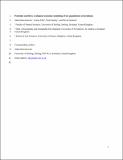Pesticides and bees : ecological-economic modelling of bee populations on farmland
Abstract
Production of insect-pollinated crops typically relies on both pesticide use and pollination, leading to a potential conflict between these two inputs. In this paper we combine ecological modelling with economic analysis to investigate the effects of pesticide use on wild and commercial bees, whilst allowing farmers to partly offset the negative effects of pesticides on bee populations by creating more on-farm bee habitat. Farmers have incentives to invest in creating wild bee habitat to increase pollination inputs due to the contribution this makes to yields. However, the optimal allocation of on-farm habitat strongly depends on the negative effects of pesticides, with a threshold-like behaviour at a critical level of the impairment. When this threshold is crossed, the population of wild bees becomes locally extinct and their availability to pollinate breaks down. We show that availability of commercial bees masks this decrease in pollination services which would otherwise incentivise farmers to conserve the wild pollinator population. Indeed, if commercial bees are available, optimum profit may be achieved by providing no habitat at all for wild bees, and allowing these wild pollinators to go extinct.
Citation
Kleczkowski , A , Ellis , C , Hanley , N & Goulson , D 2017 , ' Pesticides and bees : ecological-economic modelling of bee populations on farmland ' , Ecological Modelling , vol. 360 , pp. 53-62 . https://doi.org/10.1016/j.ecolmodel.2017.06.008
Publication
Ecological Modelling
Status
Peer reviewed
ISSN
0304-3800Type
Journal article
Description
Authors thank the European Investment Bank (EIB) University Research Action Programme for financial support of this work through the ECO-DELIVERY project.Collections
Items in the St Andrews Research Repository are protected by copyright, with all rights reserved, unless otherwise indicated.

